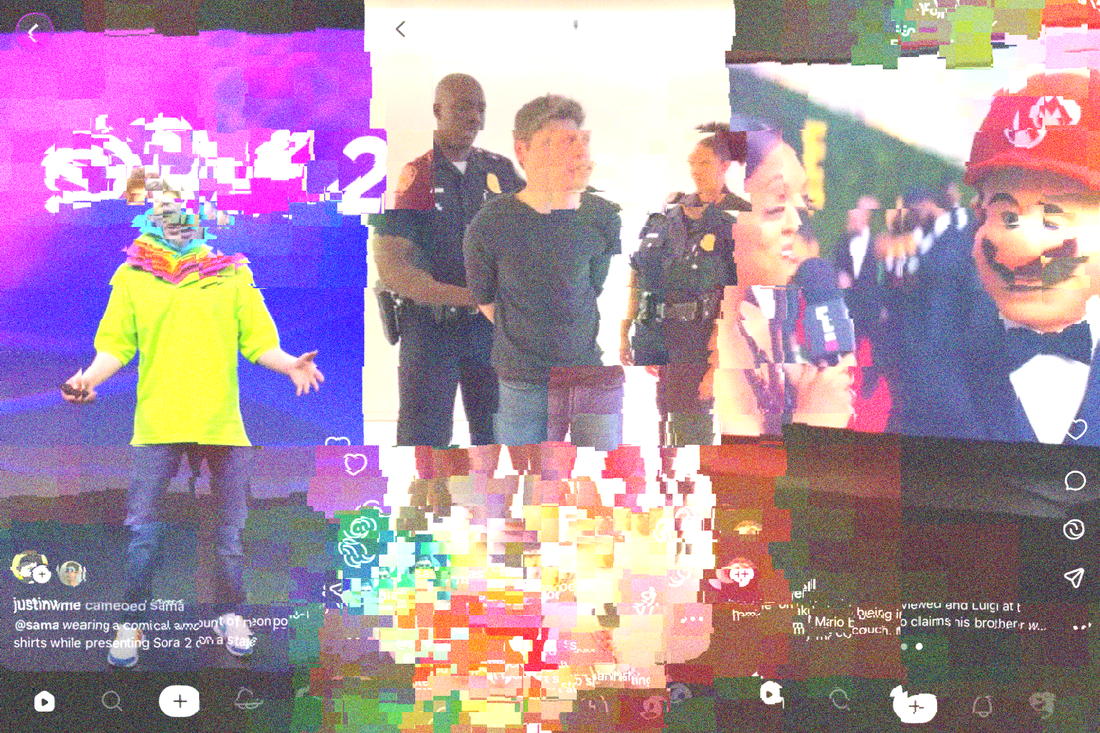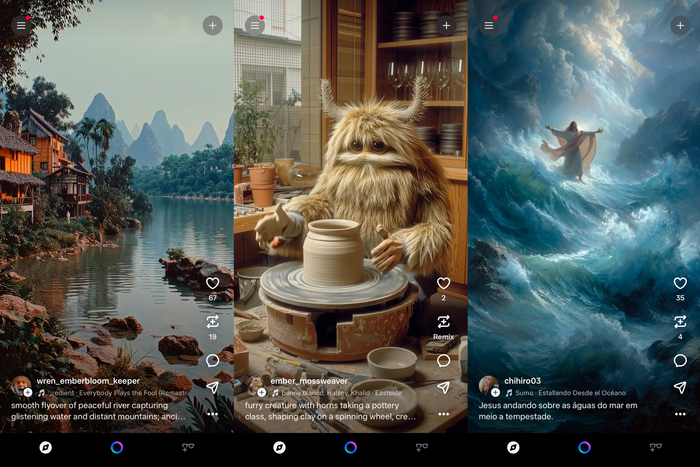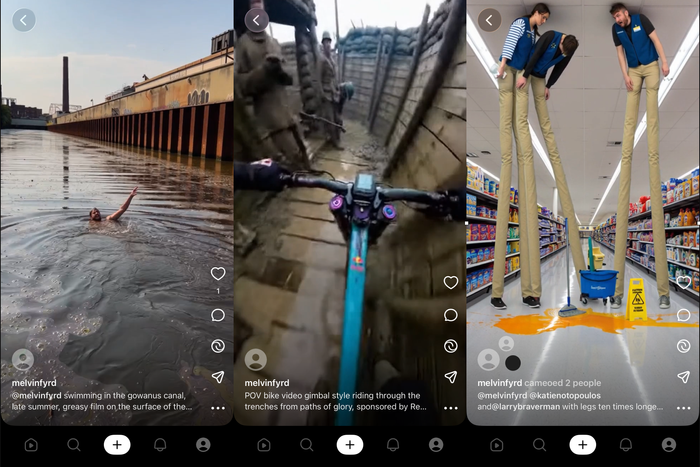
Photograph-Illustration: Intelligencer; Photograph: Sora
Final week, Meta’s newly appointed chief AI officer, Alexandr Wang, who co-founded the AI data-collection and annotation agency Scale.ai, introduced Vibes, “a brand new feed within the Meta AI app for short-form, AI-generated movies.” Early responses have been mainly unanimous: What? Why? In testing, it felt, at most, like an opportunity to check out latest clip-generation tech free of charge. In any other case, the feed was unfocused and complicated, stuffed with overcooked generations by strangers unified solely by the drab meta-aesthetics which have come to outline AI imagery over the past couple of years: CGI-ish surroundings and characters; actual locations and other people rendered as uncanny inventory pictures; the work of Thomas Kinkade if he received into microdosing mushrooms. Even the extra optimistic evaluations couldn’t assist however name it a feed of slop.
Photograph: Vibes
In hindsight, although, the discharge of Vibes now makes a little bit extra sense. Meta, which has been spending huge quantities of cash to poach expertise from different AI companies, most likely knew an awesome deal about what OpenAI was about to launch: a brand new model of its video-generation product, Sora, this time packaged as a TikTok-style app, dropped on Tuesday. In distinction with Vibes, Sora — an invite-only app with restricted entry — was an instantaneous viral hit.
What’s the distinction? Underlying fashions matter a little bit bit right here. In an obvious rush to get the app out, and missing higher tech of its personal, Meta ended up leaning on an out of doors image-and-video-generation firm. In the meantime, the most recent OpenAI mannequin is clearly extra able to producing what you ask it for, whether or not that’s a reasonably reasonable clip of an actual particular person doing one thing regular, a jokey visible mash-up — or one thing stranger or extra illicit, regardless of OpenAI’s makes an attempt to incorporate a variety of guardrails. Early examples going round on social media included macabre or gross movies, the nonconsensual likenesses of public figures, and copyrighted characters. The Sora movies tended to really feel both shockingly good, form of dirty, or each (its personal simply circumventable guidelines are notable, however as a lot as something make it not possible to disregard the vastly extra dire prospects that exist already past the platform, courtesy of open and more and more succesful video-generation fashions).
What actually made the app work, nevertheless, have been two options. One inspired customers to create avatars of themselves, known as Cameos, which may then be included in movies. The opposite was the power to, with customers’ permission, embrace their Cameos in your movies. Among the first movies to get momentum on Sora have been individuals making jokes about Sam Altman, commanding his avatar into numerous absurd, embarrassing, or just surprising conditions.
Much more compelling, although, was to strive Sora with individuals you recognize. If the sanctioned (and in the end flattering) ritual of teasing OpenAI’s CEO along with his personal product because it harvested customers’ likenesses outlined early common content material, the expertise of really utilizing the app was outlined by stranger and extra private experiences. Oh, there’s a model of me, trying and sounding barely fallacious however uncomfortably acquainted, working at my command. Oh, I can embrace a pal on this one, and I could make him say or do no matter we would like.
Sora, the mannequin, is a tech demo. Sora, the feed, is an experiment tucked right into a TikTok clone, solely considerably extra fascinating than Vibes. Sora, the consensual deep-fake automator, makes essentially the most sense within the context of a bunch chat, or throughout the app in little-noticed interactions between pals. Messing round with your individual avatar is unsettling, fascinating, and entertaining, an within the queasy custom of social-media face filters or these outdated apps that used “AI” to make you look outdated in alternate to your privateness. Messing round with the avatars of individuals you recognize, collectively, is startling and enjoyable. Utilizing Sora is a bit like dressing up as each other for Halloween: It’s simple to get amusing and simple to go a little bit bit too far.
Photograph: Sora
Sora is presumably extraordinarily costly to run, therefore OpenAI’s use of a chained invite program to roll it out. In its early kind, it brings to thoughts the early days of picture turbines like Midjourney, the video mannequin for which Meta is now borrowing for Vibes. Like Sora, Midjourney in 2022, was a captivating demo that was, for just a few days, actually enjoyable to mess with for lots of the identical causes:
A overwhelming majority of the photographs I’ve generated have been jokes — most for pals, others between me and the bot. It’s enjoyable, for some time, to interrupt a chat about which mousetrap to purchase by asking a supercomputer for a horrific rendering of a person caught in a mattress of glue or to reply to a shared Zillow hyperlink with a rendering of a “McMansion Pyramid of Giza…”
…I nonetheless use Midjourney this fashion, however the novelty has worn off, in no small half as a result of the renderings have simply gotten higher — much less “unusual and exquisite” than “competent and believable.” The bit has additionally gotten stale, and I’ve mapped the slim boundaries of my creative creativeness.
Enjoying with Sora is an identical expertise: a destabilizing encounter with a wierd and uncomfortable expertise that may quickly change into ubiquitous but in addition quickly and surprisingly banal. It additionally produces comparable outcomes: a bunch of generations which might be fascinating to you and your mates however seem like slop to anybody else. The considerable glitches, like my avatar’s tendency to incorporate counting in all dialogue, assist make the generations fascinating. Lots of the movies that are compelling past the context of their creation are fascinating largely as specimens or artifacts — that’s, as examples of how a immediate (“sam altman mounted to the wall like a giant mouth Billy bass, full physique”) will get translated into … one thing. (As one pal famous, many of those movies change into unwatchable should you can’t see what the immediate was.)
This makes Sora fascinating to check to extra straightforwardly “social” networks, the place most content material is likewise produced for small audiences and lacks attraction past that context. Right here, too, celebrities and types are what individuals need to see, however with the expectation that they are often commanded and manipulated, not simply consumed. Sora: It’s fairly fucking bizarre!
It’s additionally clearly compelling, and it (or imitations of it) are going to confront far more individuals — quickly. OpenAI’s willingness to launch unusual, glitchy preview merchandise (and to gleefully violate norms within the course of) is at this level a longtime technique and one which has reliably netted it customers (within the case of ChatGPT, which now has a whole lot of tens of millions of customers) or at the very least renewed consideration (as when OpenAI demonstrated new image-generation instruments by way of a viral aesthetic rip-off marketing campaign). By way of the AI “alignment” debate, for no matter it’s price, the main AI agency optimizing its product output for engagement is someplace between “dangerous” and “apocalyptic.” It’s additionally one thing that Meta, regardless of its repute for engagement-at-all-cost product design, can’t appear to drag off irrespective of how exhausting it tries.
Within the broader discourse round what trendy AI is for and the place it could be going, it’s additionally helpful to attempt to reconcile with a few of the rhetoric from corporations like OpenAI about why they should increase a lot cash to construct so many knowledge facilities. (For a glimpse of the view from inside Google, see the above posts from individuals who work on AI there.) Are we making an attempt to treatment most cancers? Out of date information employees? Construct robots? Compete with Instagram? Purchase some extra runway? For now, the reply appears to be, “Hey, try Sora, the app the place you possibly can make Sam Altman dance.”





